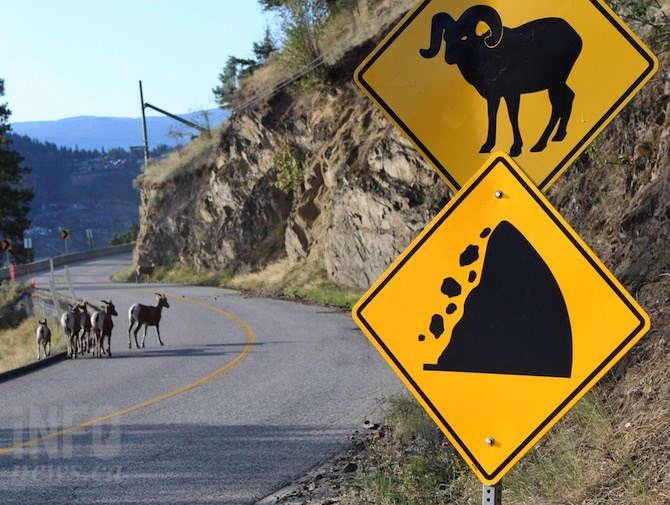
These sheep liked the area near the sheep warning sign between Traders Cove and Lake Okanagan Resort.
(ROB MUNRO / iNFOnews.ca)
August 21, 2022 - 6:04 PM
Diseases are preventing Bighorn sheep populations in the South Okanagan from having lambs.
On the east side of the Okanagan Valley, herds are affected by a bacteria called Mycoplasma ovipneumoniae.
“There has been almost nil, or zero lamb recruitment in the Okanagan because of this,” according to Chris Barker, vice president of Wild Sheep Society of B.C.
He said there is no vaccine, but euthanizing the infected members of a population is an effective treatment solution.
“You want to remove those ewes,” Barker said.
But until policies are aligned with with those in Washington State, he says there isn’t much point in treating the sheep in Canada, as the populations share a habitat on both sides of the border. It’s also important for owners of domesticated sheep to keep their livestock separated from wild sheep.
“We need (the agricultural industry) to come up with legislation.”
It's the second year Mycoplasma ovipneumoniae has prevented east Okanagan lambs from surviving.
The same disease has become an issue in the Fraser Valley as well, but Barker said treatment efforts there are proving to be effective.
He is hopeful that treatment procedures, which take about two to three weeks to complete, will happen along the east side of the Okanagan in 2023.
READ MORE: Wildfires are good for the Southern Interior’s herds of bighorn sheep
On the west side of the valley, Bighorn sheep are infected by an ear mite called Psoroptes, which causes their ears to droop and scab. Barker said the sheep don’t appear to be too impacted by the disease, however it may be harder for them to hear predators with infected ears.
There is no known solution but experiments have been conducted at a lab on the Penticton Indian Band, Barker said.
Down in the Grand Forks area, the sheep populations are having a good year so far. Last year there were worries that another illness – Blue tongue disease – might wipe out the entire herd. But new lambs have been observed in 2022, although a population count won’t happen until the fall.
There were also concerns Blue tongue would spread to other parts of the province due to favourable weather patterns in 2021, however that did not happen.
The Grand Forks herd is even in good enough shape for its sheep to be transplanted and added to weaker herds. However, with so many active diseases in B.C., Barker said it’s not a good idea to move sheep around the province this year.
With so many diseases impacting the province’s wild sheep this year, Barker said critical issues like habitat loss have been put on the back burner.
Despite the challenges that face bighorn sheep, he doesn't believe any of the situations are dire.
“I wouldn’t be volunteering my time for over 30 years if I wasn’t an optimist.”
In West Kelowna – along Westside Road between Bear Creek Provincial Park and La Casa Cottages – Barker was happy to report that sheep herds are in healthy shape.
"As long as no domestic sheep are part of their habitat they will remain safe."
To contact a reporter for this story, email Dan Walton or call 250-488-3065 or email the editor. You can also submit photos, videos or news tips to the newsroom and be entered to win a monthly prize draw.
We welcome your comments and opinions on our stories but play nice. We won't censor or delete comments unless they contain off-topic statements or links, unnecessary vulgarity, false facts, spam or obviously fake profiles. If you have any concerns about what you see in comments, email the editor in the link above.
News from © iNFOnews, 2022